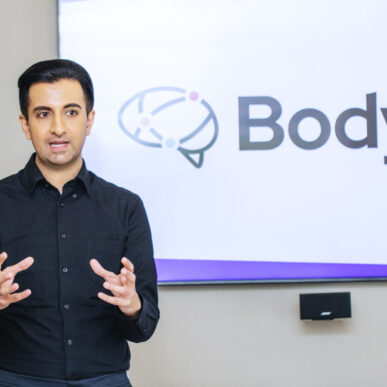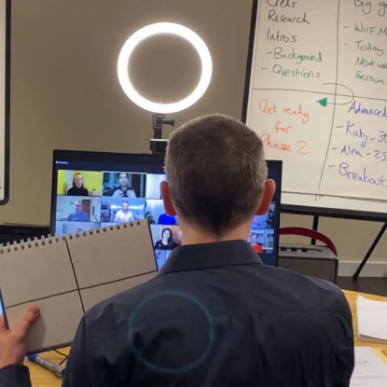How To Memorise A Speech (and Bad Habits To Avoid!)

Have you ever been in the daunting position of having to memorise a speech?
We’ve all felt that fear. What if I forget what I’m planning to say? Or if my mind goes completely blank? Imagine if everyone’s staring at me while I stand there, saying nothing?
People often ask us ‘what’s the best way to remember a speech’? They insist they’ve tried everything and their brain simply won’t take it in. However, people are often unaware that bad habits can prevent them from being comfortable with their presentation. By overcoming these habits, you’ll release your full potential to connect with people, inspire them and make your ideas happen.
In this blog, we look at top tips for memorising a presentation – and which bad habits you should avoid.
TIP #1: WRITE YOUR NOTES ON PAPER, NOT A LAPTOP
If you are trying to memorise a speech of any length, write notes with an actual pen and paper — not a laptop.
Physically writing things down connects you with the information, cementing it in your memory. And don’t write it out word for word or in full sentences. Remember: these are notes. They’re just for you, so they only need to make sense to you.
You can underline key ideas, highlight things, use arrows, etc. And if you’ve got a bit of time, you can then try rehearsing the talk out loud, based on those notes, writing changes, arrows and underlining where you need to.
Once you’ve got the page figured out, whenever you see it, you’ll think, “I know exactly what I’m doing for this talk.”
TIP #2: YOU DON’T NEED TO MEMORISE EVERY WORD
One of the biggest mistakes people make is trying to memorise every word of their presentation.
The average speaker talks about 140 words per minute. If you need to give a 30-minute speech, then you’re potentially going to have memorize 4,000 words in sequence!
That’s simply not going to happen.
Even if you succeed, you’ll get stuck in your head during the sequencing process, and run the risk of losing your audience. More than that, you’ll be effectively giving a performance rather than connecting with people.
Think of it this way. Justin Timberlake performed the Super Bowl half-time show to nearly 300 million viewers. When asked if he was nervous about messing up, he said, “You can’t focus on being perfect. Perfection gets in the way of greatness. It doesn’t actually matter if you mess up. You’ve just got to be out there, passionately connected with people.”
So, I always say, “Don’t aim for ‘word perfect,’ because it’s more important you aim for connection.”
TIP #3: MEMORISE YOUR SPEECH WITH ‘TRIGGER WORDS’, NOT A SCRIPT
Rather than trying to remember your whole script, use ‘trigger words’ instead. These are short, simple words or phrases that can help you remember what you are planning to say. When you glance at a trigger word, your brain switches on and thinks, “Oh, yes. That’s the big picture subject I wanted to talk about. Oh, yes. That’s the detail I wanted to talk about. Oh, yes. That’s the action I wanted to talk about.”
Trigger words can help to give us comfort that we’re not going to forget the important parts of our presentation, but also don’t hold us back by being too long to read. It could be something simple like bullet points that say things like ‘Last year / Goals / Case study’ – whatever it will take to get you to remember your key points.
Using trigger words is not ‘cheating’ or a sign of being unable to memorise your speech.
Experts use trigger words
I’ve seen top speakers like Tony Robbins deliver compelling talks based on trigger words that are on large pieces of paper, taped to the floor in front of them. So while you could have them on the lectern with you, you could also place your trigger words anywhere in your line of sight during your speech. I just suggest you avoid holding them. Keep your hands free to speak more naturally with the audience. Pop your notes down somewhere and write the ‘trigger words’ big enough that you can easily see them from a short distance away.
Of course, for a shorter talk, you can memorise your keywords. As long as you capture each of the main thoughts as you speak, and keep going in the right direction, you’ll have a flow through what you’re saying. And your mind can leap from one key idea to the next all the way through to the end of your speech.
TIP #4: REHEARSE OUT LOUD (AND DON’T BE TEMPTED TO ‘WING IT’)
Some people think they may sound better by improvising their speech with no plan or structure.
Or they may think to themselves, “There’s no point memorizing this because I will mess up, so I’m just going to go up there with no notes and hope for the best.” This can be an issue with self-sabotage (if someone criticises you when you haven’t prepared properly you can say “well, that wasn’t my best work”), but it’s a bad habit nonetheless — and one that can leave a lasting, negative impression with the audience.
For example, Ed Miliband was the leader of the Labour Party in the UK. At a conference in 2014, he stood up to speak without any notes. He intended to mention the economy — a pretty crucial point for a political party with a strong interest in workers’ rights — but he completely forgot. He walked offstage thinking he’d done a decent job, but afterward, he was blasted on social media for not covering a key issue that was important to many people across the country.
Winging it won’t help you deliver your best presentation. Great speakers prepare.
Instead, try to rehearse what you’re going to say out loud. If you want to sound natural, have your trigger words (above) to help you remember what’s coming next. If nothing else, make sure you have rehearsed what you are going to say at the very beginning and at the end of your presentation, so that you know you can start and finish with confidence.
Remember, rehearsing also allows you to hone your body language, pitch and pace so that you can deliver your presentation with maximum impact.
TIP #5: DON’T READ FROM YOUR SLIDES
People rely too heavily on slides, thinking they’re a quick way to memorise a speech.
Unfortunately, this isn’t the case.
Whenever I’m working with someone, I pull them away from the idea that notes on slides are a necessity. Not only are bullet-points boring, but they can come off as patronizing. People don’t need you to tell them something they can easily read, and this type of “spoon feeding” can turn off even the most passionate audience.
More than that, putting all your information on a screen above you makes your speaking redundant. Why should anyone pay attention to you if everything you’re saying is in front of them already?
THE GOLDEN RULE: STRUCTURE YOUR TALK TO MATCH THE WAY PEOPLE THINK
The best way to help you memorise a speech quickly is to follow a structure that flows in the same way that people think. This will not only be more compelling for your audience, but will help you to remember it too.
It means breaking your content down into three elements: big picture, details, and actions.
- Big picture sets the context for your talk. Think about what people need to know about you, your company, or your project. As soon as you start speaking, people think, “Why should I listen to you?” Answering this immediately compels your listeners while being an easy first point to always remember.
- Details must come after the big picture. It’s a natural flow to go from big to small, so it will be easy for you to follow, especially if you whittle your details down to a maximum of three items. Your brain finds it easiest to remember three key areas or ideas — and so will your audience.
- Actions are what you want your audience to do when you’ve finished speaking. Make sure you’re bringing the talk to a close with a definitive ending rather than just running out of things to say. Choosing a final call to action brings you to a definitive point that moves things forward.
After putting together your points in this structure, you’ll have a formula your brain can always rely on that’s also simple for your audience to follow — no matter how long you’re speaking for.
All of this will help you to achieve the only thing that really matters, which is that you connect with your audience in a human and engaging way.
To learn more about how we can help you please contact our team.




















